System Thinking and Sustainability Challenges
VerifiedAdded on 2023/05/28
|13
|2970
|495
AI Summary
This paper evaluates how system thinking can be used to alleviate the sustainability problems with reference to tourism trap and renewable energy in Australia. It discusses the characteristics of wicked problems and how system thinking approach can be used to solve complex challenges facing societies. The paper also explores how system thinking can alleviate the tourism trap and associated implications by allowing the connection, synthesis, collaboration, integration and co-creation of every component affecting the system. Finally, it discusses how system thinking can be used to understand and develop solutions for renewable energy sustainability.
Contribute Materials
Your contribution can guide someone’s learning journey. Share your
documents today.
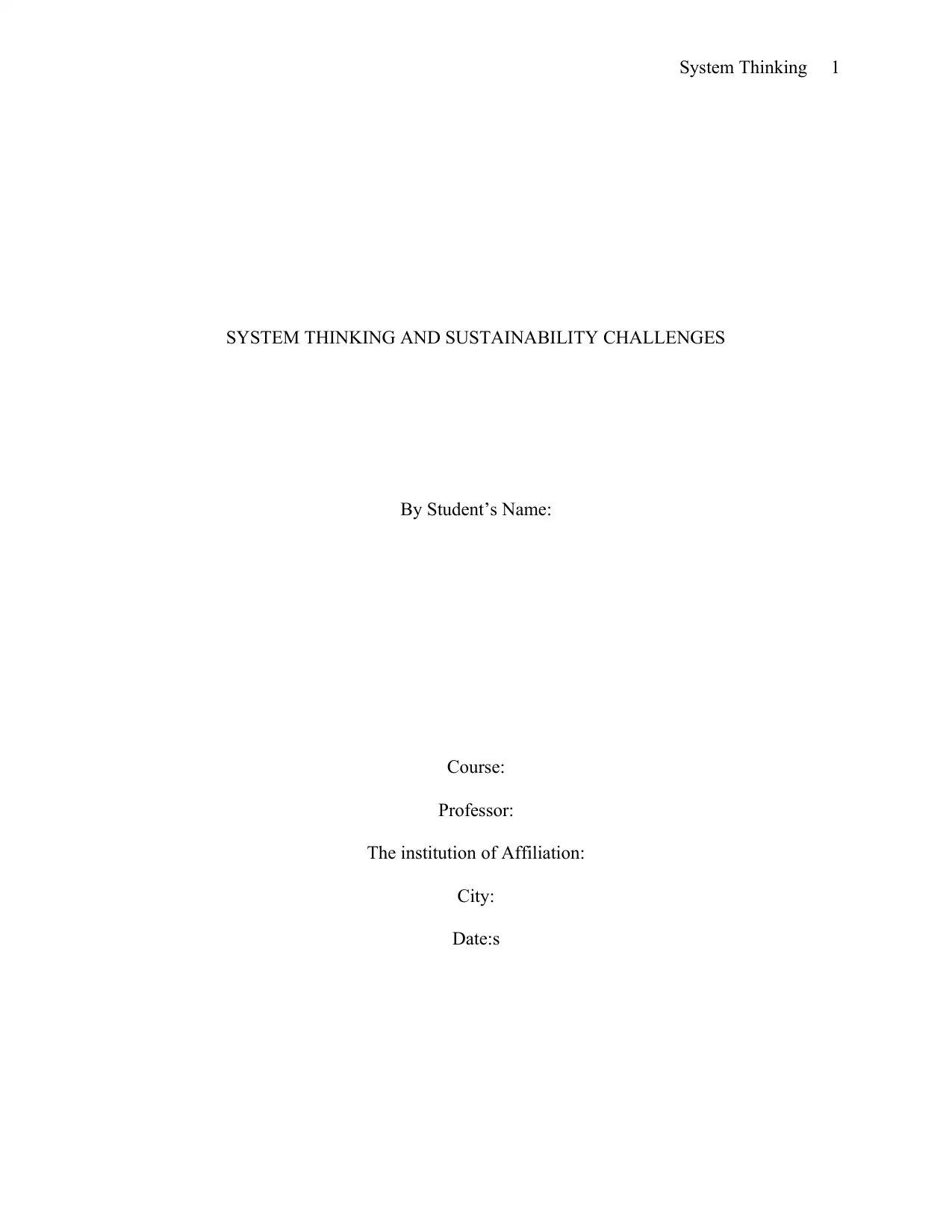
System Thinking 1
SYSTEM THINKING AND SUSTAINABILITY CHALLENGES
By Student’s Name:
Course:
Professor:
The institution of Affiliation:
City:
Date:s
SYSTEM THINKING AND SUSTAINABILITY CHALLENGES
By Student’s Name:
Course:
Professor:
The institution of Affiliation:
City:
Date:s
Secure Best Marks with AI Grader
Need help grading? Try our AI Grader for instant feedback on your assignments.

System Thinking 2
Introduction
The current generation is faced with a myriad of sustainability challenges never faced by
humanity before especially climate change. With the ever-growing human population amid of
resource scarcity, people have exerted overwhelming pressure on the available and limited
resources to point they are no longer sustainable (Lezak & Thibodeau, 2016, p. 144). All the
seventeen Sustainability Development Goals are centred on ensuring humanity and the
environment continue to harmoniously and mutualistically coexist where man protects and
conserves the environment for the betterment of humankind. In this Anthropocene era
characterised by climate change, extreme scarcity of sources due to overexploitation, poverty,
and other socio-economic factors, there is a dire need to ensure sustainability and responsible use
of available resources. Thus, sustainability is a central theme in every sector across the globe.
Nonetheless, an overarching question is engraved on how to achieve sustainability in our
sectors. Many theorists and scholars have coined different approaches to sustainability problems;
however, most prove inevitably unable to mitigate the issues satisfactorily. The world is complex
and dynamic characterised by interdependently interacting contexts in multifaceted levels.
Adversity in one sector has a potential of significantly offsetting balance in another part.
Therefore, the concept of system thinking was postulated. It argues that sustainability problems
can be mitigated by looking at the challenges from a systems-based perspective rather than
approaching them from a reductionist standpoint (Lezak & Thibodeau, 2016, p. 145; Pandey &
Kumar, 2016, p. 81). This paper evaluates how system thinking can be used to alleviate the
sustainability problems with reference to tourism trap and renewable energy in Australia.
Introduction
The current generation is faced with a myriad of sustainability challenges never faced by
humanity before especially climate change. With the ever-growing human population amid of
resource scarcity, people have exerted overwhelming pressure on the available and limited
resources to point they are no longer sustainable (Lezak & Thibodeau, 2016, p. 144). All the
seventeen Sustainability Development Goals are centred on ensuring humanity and the
environment continue to harmoniously and mutualistically coexist where man protects and
conserves the environment for the betterment of humankind. In this Anthropocene era
characterised by climate change, extreme scarcity of sources due to overexploitation, poverty,
and other socio-economic factors, there is a dire need to ensure sustainability and responsible use
of available resources. Thus, sustainability is a central theme in every sector across the globe.
Nonetheless, an overarching question is engraved on how to achieve sustainability in our
sectors. Many theorists and scholars have coined different approaches to sustainability problems;
however, most prove inevitably unable to mitigate the issues satisfactorily. The world is complex
and dynamic characterised by interdependently interacting contexts in multifaceted levels.
Adversity in one sector has a potential of significantly offsetting balance in another part.
Therefore, the concept of system thinking was postulated. It argues that sustainability problems
can be mitigated by looking at the challenges from a systems-based perspective rather than
approaching them from a reductionist standpoint (Lezak & Thibodeau, 2016, p. 145; Pandey &
Kumar, 2016, p. 81). This paper evaluates how system thinking can be used to alleviate the
sustainability problems with reference to tourism trap and renewable energy in Australia.
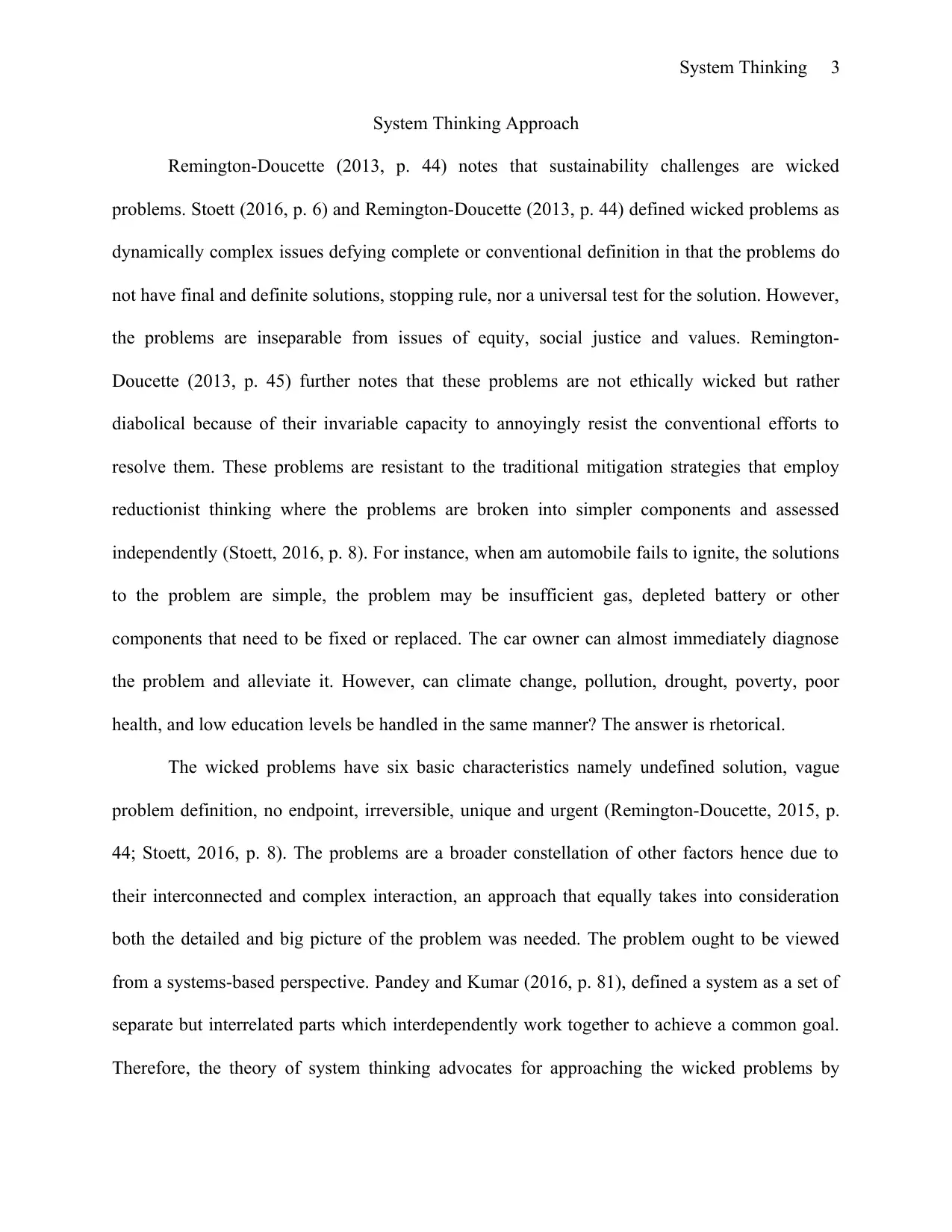
System Thinking 3
System Thinking Approach
Remington-Doucette (2013, p. 44) notes that sustainability challenges are wicked
problems. Stoett (2016, p. 6) and Remington-Doucette (2013, p. 44) defined wicked problems as
dynamically complex issues defying complete or conventional definition in that the problems do
not have final and definite solutions, stopping rule, nor a universal test for the solution. However,
the problems are inseparable from issues of equity, social justice and values. Remington-
Doucette (2013, p. 45) further notes that these problems are not ethically wicked but rather
diabolical because of their invariable capacity to annoyingly resist the conventional efforts to
resolve them. These problems are resistant to the traditional mitigation strategies that employ
reductionist thinking where the problems are broken into simpler components and assessed
independently (Stoett, 2016, p. 8). For instance, when am automobile fails to ignite, the solutions
to the problem are simple, the problem may be insufficient gas, depleted battery or other
components that need to be fixed or replaced. The car owner can almost immediately diagnose
the problem and alleviate it. However, can climate change, pollution, drought, poverty, poor
health, and low education levels be handled in the same manner? The answer is rhetorical.
The wicked problems have six basic characteristics namely undefined solution, vague
problem definition, no endpoint, irreversible, unique and urgent (Remington-Doucette, 2015, p.
44; Stoett, 2016, p. 8). The problems are a broader constellation of other factors hence due to
their interconnected and complex interaction, an approach that equally takes into consideration
both the detailed and big picture of the problem was needed. The problem ought to be viewed
from a systems-based perspective. Pandey and Kumar (2016, p. 81), defined a system as a set of
separate but interrelated parts which interdependently work together to achieve a common goal.
Therefore, the theory of system thinking advocates for approaching the wicked problems by
System Thinking Approach
Remington-Doucette (2013, p. 44) notes that sustainability challenges are wicked
problems. Stoett (2016, p. 6) and Remington-Doucette (2013, p. 44) defined wicked problems as
dynamically complex issues defying complete or conventional definition in that the problems do
not have final and definite solutions, stopping rule, nor a universal test for the solution. However,
the problems are inseparable from issues of equity, social justice and values. Remington-
Doucette (2013, p. 45) further notes that these problems are not ethically wicked but rather
diabolical because of their invariable capacity to annoyingly resist the conventional efforts to
resolve them. These problems are resistant to the traditional mitigation strategies that employ
reductionist thinking where the problems are broken into simpler components and assessed
independently (Stoett, 2016, p. 8). For instance, when am automobile fails to ignite, the solutions
to the problem are simple, the problem may be insufficient gas, depleted battery or other
components that need to be fixed or replaced. The car owner can almost immediately diagnose
the problem and alleviate it. However, can climate change, pollution, drought, poverty, poor
health, and low education levels be handled in the same manner? The answer is rhetorical.
The wicked problems have six basic characteristics namely undefined solution, vague
problem definition, no endpoint, irreversible, unique and urgent (Remington-Doucette, 2015, p.
44; Stoett, 2016, p. 8). The problems are a broader constellation of other factors hence due to
their interconnected and complex interaction, an approach that equally takes into consideration
both the detailed and big picture of the problem was needed. The problem ought to be viewed
from a systems-based perspective. Pandey and Kumar (2016, p. 81), defined a system as a set of
separate but interrelated parts which interdependently work together to achieve a common goal.
Therefore, the theory of system thinking advocates for approaching the wicked problems by

System Thinking 4
looking at the individual components of the more extensive system and their interrelationship
with other components. For instance, if a community is faced with unprecedented rates of
infections, health care providers can either continually prescribe relevant drugs or can opt to
approach the problem from a larger view. They can look at the correlation of social departments
of health such as hygiene, air quality, climate change or literacy levels with the health outcome.
By doing so, they will have a broader and detailed understanding of the problem from the
interrelatedness of the social determinant and health outcome hence devising appropriate
mitigation strategy.
Kim (2012) posit that system thinking adopts a transdisciplinary framework of assessing
the interrelationships between and among things instead only the patterns of change and static
snapshots. A system thinker can approach a problem in terms of the behavioural patterns over
time as opposed to emphasising on particular events; that is having a macroscopic understanding
than the microscopic view. Thus, this broader approach provides a better conceptualisation of the
problem hence arguably invaluable in addressing sustainability challenges.
Pandey and Kumar (2016, p. 81) indicate that the ability of system thinking approach to
view problems from a comprehensive view makes it able to solve complex challenges facing
societies. For instance, Remington-Doucette (2013, p. 60) illustrates how system thinking would
have been used to understand and resolve the 2007/8 Food Crisis (see Figure 1). The diagram
below shows different interacting components with the potential of resulting in a food crisis.
When the components are individual and comprehensive assessed alongside each other, a clear
perspective of the problem is found as well as the solution.
looking at the individual components of the more extensive system and their interrelationship
with other components. For instance, if a community is faced with unprecedented rates of
infections, health care providers can either continually prescribe relevant drugs or can opt to
approach the problem from a larger view. They can look at the correlation of social departments
of health such as hygiene, air quality, climate change or literacy levels with the health outcome.
By doing so, they will have a broader and detailed understanding of the problem from the
interrelatedness of the social determinant and health outcome hence devising appropriate
mitigation strategy.
Kim (2012) posit that system thinking adopts a transdisciplinary framework of assessing
the interrelationships between and among things instead only the patterns of change and static
snapshots. A system thinker can approach a problem in terms of the behavioural patterns over
time as opposed to emphasising on particular events; that is having a macroscopic understanding
than the microscopic view. Thus, this broader approach provides a better conceptualisation of the
problem hence arguably invaluable in addressing sustainability challenges.
Pandey and Kumar (2016, p. 81) indicate that the ability of system thinking approach to
view problems from a comprehensive view makes it able to solve complex challenges facing
societies. For instance, Remington-Doucette (2013, p. 60) illustrates how system thinking would
have been used to understand and resolve the 2007/8 Food Crisis (see Figure 1). The diagram
below shows different interacting components with the potential of resulting in a food crisis.
When the components are individual and comprehensive assessed alongside each other, a clear
perspective of the problem is found as well as the solution.
Secure Best Marks with AI Grader
Need help grading? Try our AI Grader for instant feedback on your assignments.
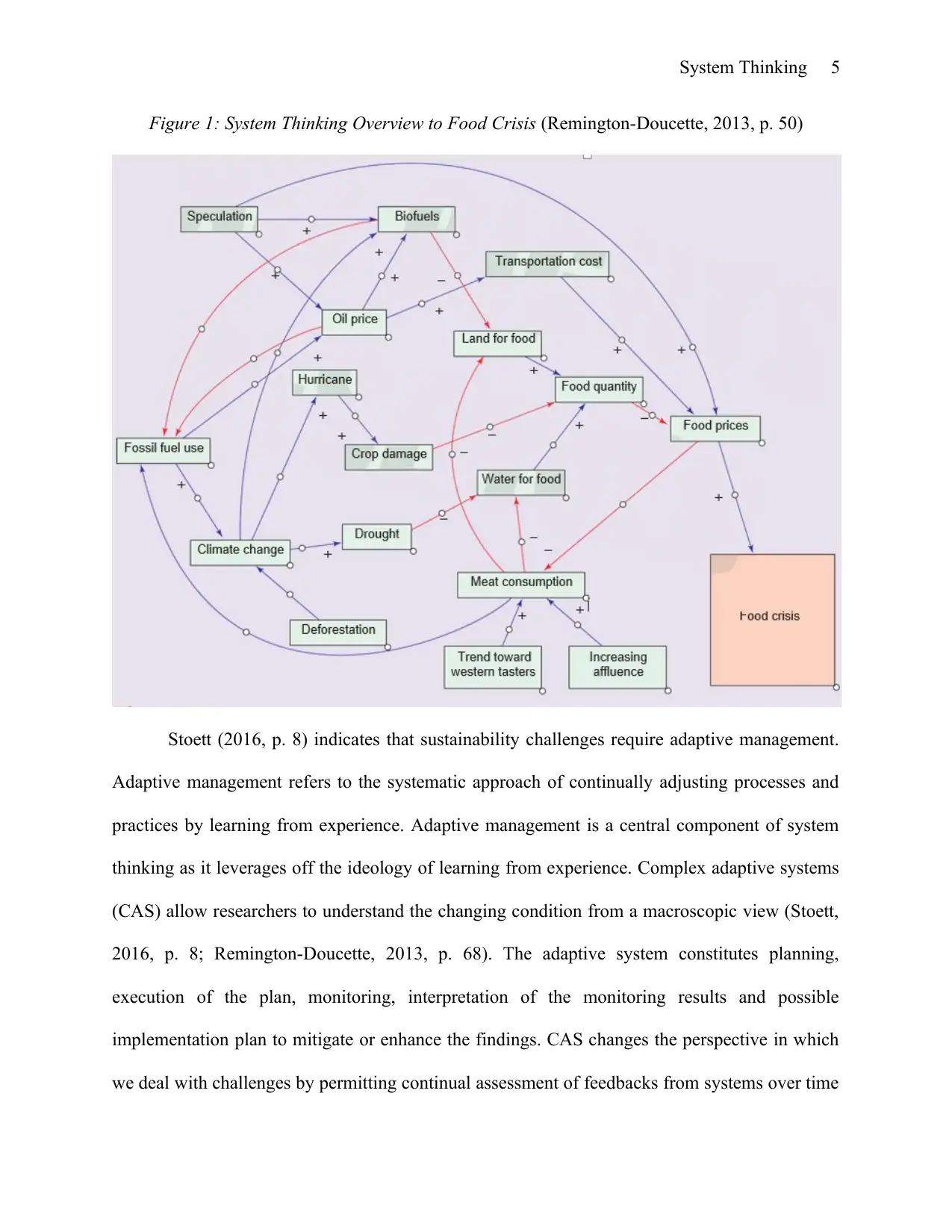
System Thinking 5
Figure 1: System Thinking Overview to Food Crisis (Remington-Doucette, 2013, p. 50)
Stoett (2016, p. 8) indicates that sustainability challenges require adaptive management.
Adaptive management refers to the systematic approach of continually adjusting processes and
practices by learning from experience. Adaptive management is a central component of system
thinking as it leverages off the ideology of learning from experience. Complex adaptive systems
(CAS) allow researchers to understand the changing condition from a macroscopic view (Stoett,
2016, p. 8; Remington-Doucette, 2013, p. 68). The adaptive system constitutes planning,
execution of the plan, monitoring, interpretation of the monitoring results and possible
implementation plan to mitigate or enhance the findings. CAS changes the perspective in which
we deal with challenges by permitting continual assessment of feedbacks from systems over time
Figure 1: System Thinking Overview to Food Crisis (Remington-Doucette, 2013, p. 50)
Stoett (2016, p. 8) indicates that sustainability challenges require adaptive management.
Adaptive management refers to the systematic approach of continually adjusting processes and
practices by learning from experience. Adaptive management is a central component of system
thinking as it leverages off the ideology of learning from experience. Complex adaptive systems
(CAS) allow researchers to understand the changing condition from a macroscopic view (Stoett,
2016, p. 8; Remington-Doucette, 2013, p. 68). The adaptive system constitutes planning,
execution of the plan, monitoring, interpretation of the monitoring results and possible
implementation plan to mitigate or enhance the findings. CAS changes the perspective in which
we deal with challenges by permitting continual assessment of feedbacks from systems over time
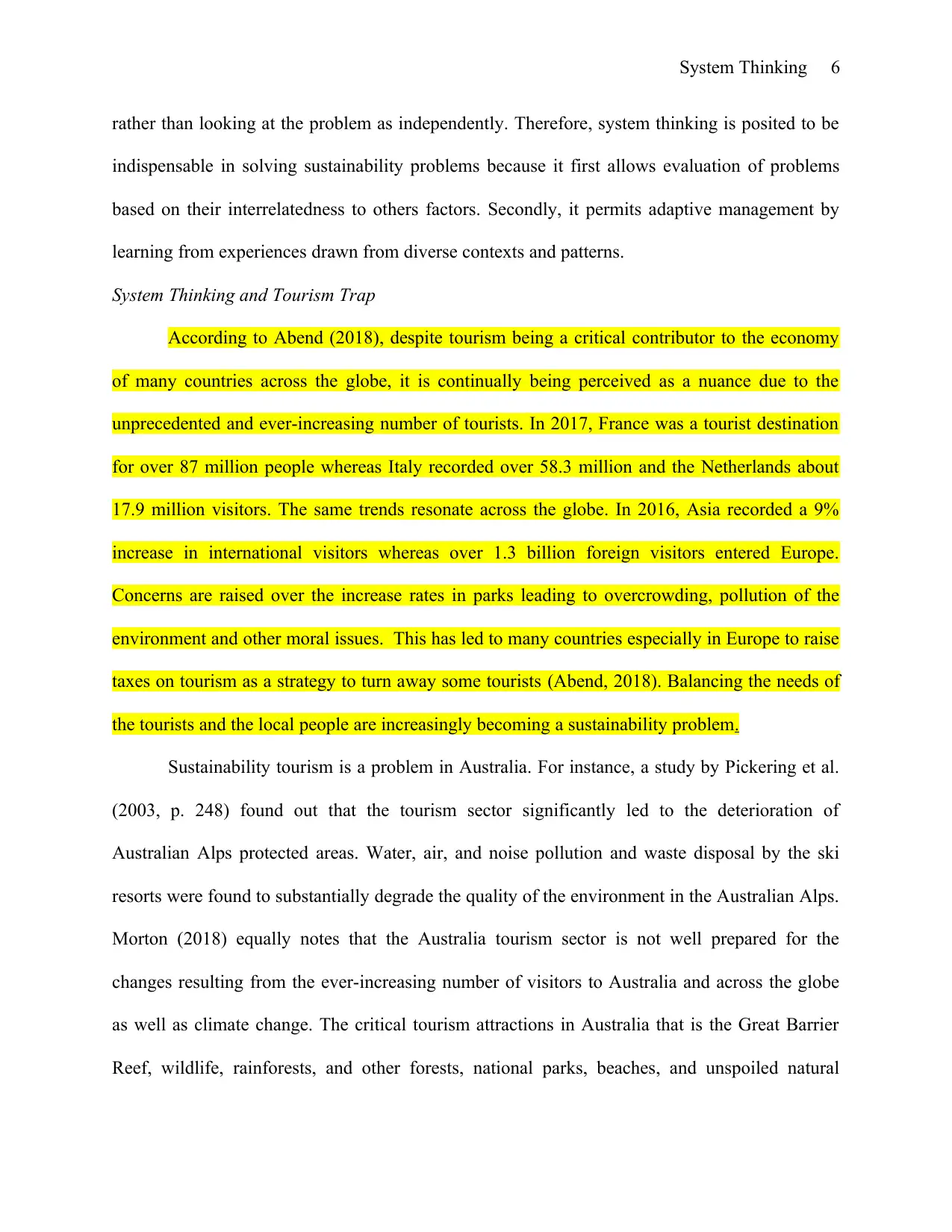
System Thinking 6
rather than looking at the problem as independently. Therefore, system thinking is posited to be
indispensable in solving sustainability problems because it first allows evaluation of problems
based on their interrelatedness to others factors. Secondly, it permits adaptive management by
learning from experiences drawn from diverse contexts and patterns.
System Thinking and Tourism Trap
According to Abend (2018), despite tourism being a critical contributor to the economy
of many countries across the globe, it is continually being perceived as a nuance due to the
unprecedented and ever-increasing number of tourists. In 2017, France was a tourist destination
for over 87 million people whereas Italy recorded over 58.3 million and the Netherlands about
17.9 million visitors. The same trends resonate across the globe. In 2016, Asia recorded a 9%
increase in international visitors whereas over 1.3 billion foreign visitors entered Europe.
Concerns are raised over the increase rates in parks leading to overcrowding, pollution of the
environment and other moral issues. This has led to many countries especially in Europe to raise
taxes on tourism as a strategy to turn away some tourists (Abend, 2018). Balancing the needs of
the tourists and the local people are increasingly becoming a sustainability problem.
Sustainability tourism is a problem in Australia. For instance, a study by Pickering et al.
(2003, p. 248) found out that the tourism sector significantly led to the deterioration of
Australian Alps protected areas. Water, air, and noise pollution and waste disposal by the ski
resorts were found to substantially degrade the quality of the environment in the Australian Alps.
Morton (2018) equally notes that the Australia tourism sector is not well prepared for the
changes resulting from the ever-increasing number of visitors to Australia and across the globe
as well as climate change. The critical tourism attractions in Australia that is the Great Barrier
Reef, wildlife, rainforests, and other forests, national parks, beaches, and unspoiled natural
rather than looking at the problem as independently. Therefore, system thinking is posited to be
indispensable in solving sustainability problems because it first allows evaluation of problems
based on their interrelatedness to others factors. Secondly, it permits adaptive management by
learning from experiences drawn from diverse contexts and patterns.
System Thinking and Tourism Trap
According to Abend (2018), despite tourism being a critical contributor to the economy
of many countries across the globe, it is continually being perceived as a nuance due to the
unprecedented and ever-increasing number of tourists. In 2017, France was a tourist destination
for over 87 million people whereas Italy recorded over 58.3 million and the Netherlands about
17.9 million visitors. The same trends resonate across the globe. In 2016, Asia recorded a 9%
increase in international visitors whereas over 1.3 billion foreign visitors entered Europe.
Concerns are raised over the increase rates in parks leading to overcrowding, pollution of the
environment and other moral issues. This has led to many countries especially in Europe to raise
taxes on tourism as a strategy to turn away some tourists (Abend, 2018). Balancing the needs of
the tourists and the local people are increasingly becoming a sustainability problem.
Sustainability tourism is a problem in Australia. For instance, a study by Pickering et al.
(2003, p. 248) found out that the tourism sector significantly led to the deterioration of
Australian Alps protected areas. Water, air, and noise pollution and waste disposal by the ski
resorts were found to substantially degrade the quality of the environment in the Australian Alps.
Morton (2018) equally notes that the Australia tourism sector is not well prepared for the
changes resulting from the ever-increasing number of visitors to Australia and across the globe
as well as climate change. The critical tourism attractions in Australia that is the Great Barrier
Reef, wildlife, rainforests, and other forests, national parks, beaches, and unspoiled natural
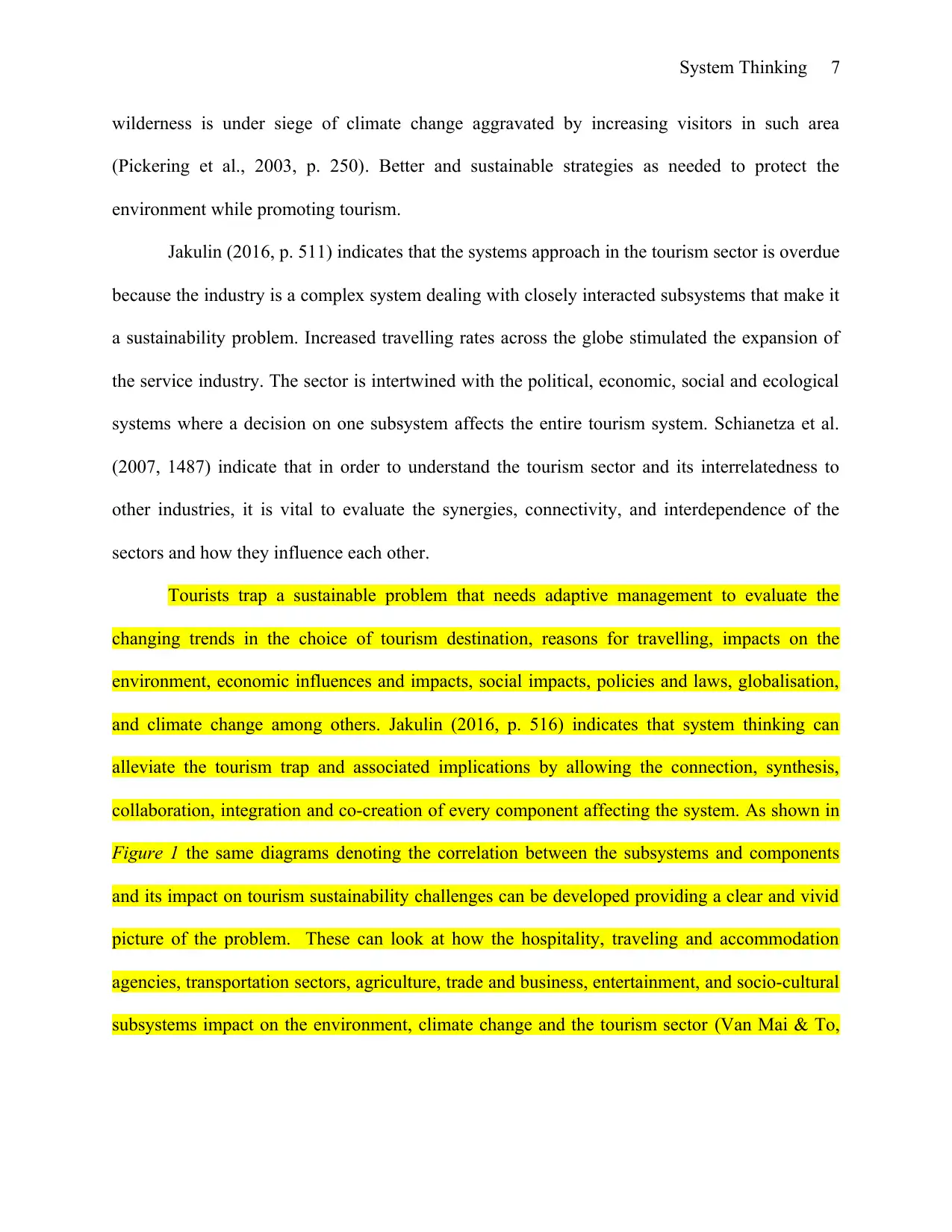
System Thinking 7
wilderness is under siege of climate change aggravated by increasing visitors in such area
(Pickering et al., 2003, p. 250). Better and sustainable strategies as needed to protect the
environment while promoting tourism.
Jakulin (2016, p. 511) indicates that the systems approach in the tourism sector is overdue
because the industry is a complex system dealing with closely interacted subsystems that make it
a sustainability problem. Increased travelling rates across the globe stimulated the expansion of
the service industry. The sector is intertwined with the political, economic, social and ecological
systems where a decision on one subsystem affects the entire tourism system. Schianetza et al.
(2007, 1487) indicate that in order to understand the tourism sector and its interrelatedness to
other industries, it is vital to evaluate the synergies, connectivity, and interdependence of the
sectors and how they influence each other.
Tourists trap a sustainable problem that needs adaptive management to evaluate the
changing trends in the choice of tourism destination, reasons for travelling, impacts on the
environment, economic influences and impacts, social impacts, policies and laws, globalisation,
and climate change among others. Jakulin (2016, p. 516) indicates that system thinking can
alleviate the tourism trap and associated implications by allowing the connection, synthesis,
collaboration, integration and co-creation of every component affecting the system. As shown in
Figure 1 the same diagrams denoting the correlation between the subsystems and components
and its impact on tourism sustainability challenges can be developed providing a clear and vivid
picture of the problem. These can look at how the hospitality, traveling and accommodation
agencies, transportation sectors, agriculture, trade and business, entertainment, and socio-cultural
subsystems impact on the environment, climate change and the tourism sector (Van Mai & To,
wilderness is under siege of climate change aggravated by increasing visitors in such area
(Pickering et al., 2003, p. 250). Better and sustainable strategies as needed to protect the
environment while promoting tourism.
Jakulin (2016, p. 511) indicates that the systems approach in the tourism sector is overdue
because the industry is a complex system dealing with closely interacted subsystems that make it
a sustainability problem. Increased travelling rates across the globe stimulated the expansion of
the service industry. The sector is intertwined with the political, economic, social and ecological
systems where a decision on one subsystem affects the entire tourism system. Schianetza et al.
(2007, 1487) indicate that in order to understand the tourism sector and its interrelatedness to
other industries, it is vital to evaluate the synergies, connectivity, and interdependence of the
sectors and how they influence each other.
Tourists trap a sustainable problem that needs adaptive management to evaluate the
changing trends in the choice of tourism destination, reasons for travelling, impacts on the
environment, economic influences and impacts, social impacts, policies and laws, globalisation,
and climate change among others. Jakulin (2016, p. 516) indicates that system thinking can
alleviate the tourism trap and associated implications by allowing the connection, synthesis,
collaboration, integration and co-creation of every component affecting the system. As shown in
Figure 1 the same diagrams denoting the correlation between the subsystems and components
and its impact on tourism sustainability challenges can be developed providing a clear and vivid
picture of the problem. These can look at how the hospitality, traveling and accommodation
agencies, transportation sectors, agriculture, trade and business, entertainment, and socio-cultural
subsystems impact on the environment, climate change and the tourism sector (Van Mai & To,
Paraphrase This Document
Need a fresh take? Get an instant paraphrase of this document with our AI Paraphraser
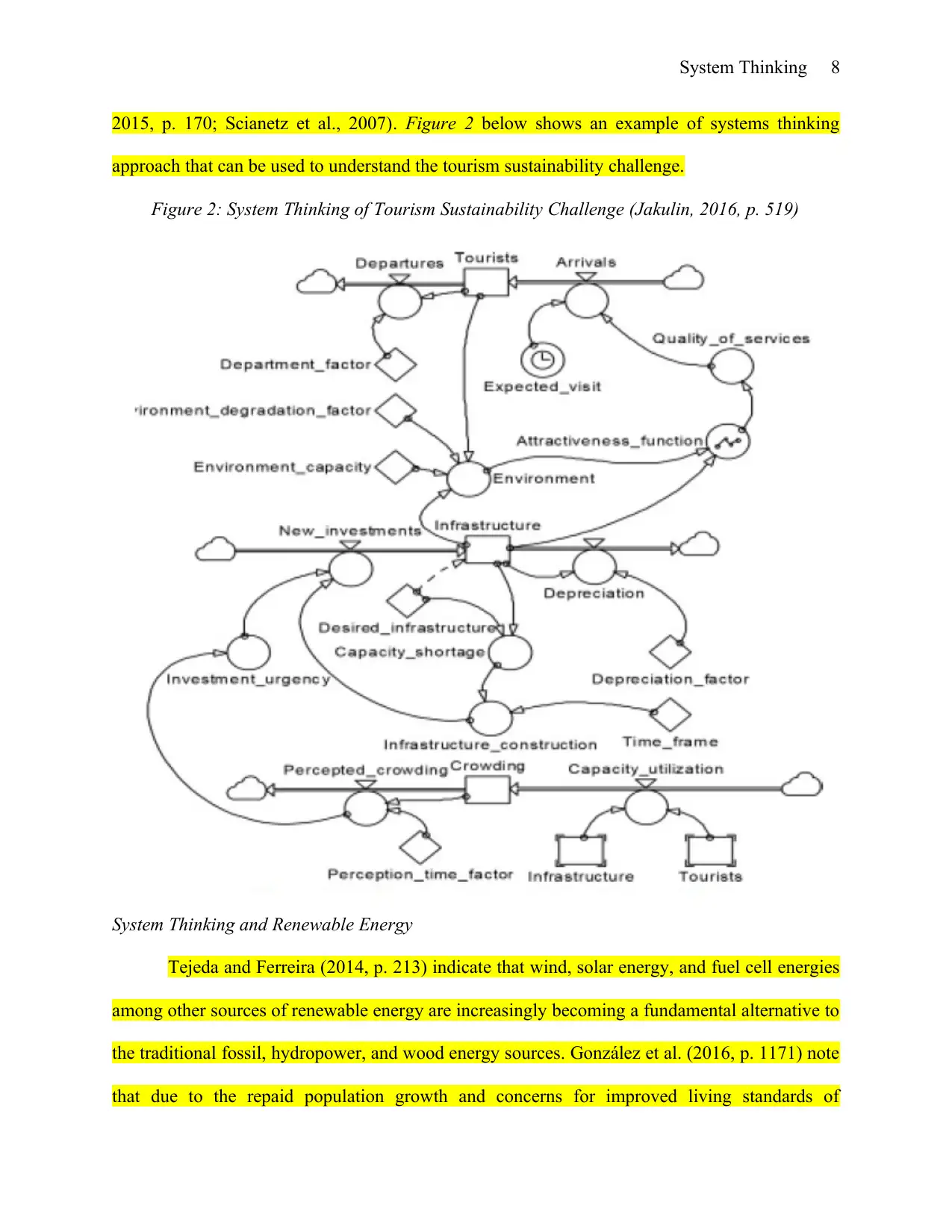
System Thinking 8
2015, p. 170; Scianetz et al., 2007). Figure 2 below shows an example of systems thinking
approach that can be used to understand the tourism sustainability challenge.
Figure 2: System Thinking of Tourism Sustainability Challenge (Jakulin, 2016, p. 519)
System Thinking and Renewable Energy
Tejeda and Ferreira (2014, p. 213) indicate that wind, solar energy, and fuel cell energies
among other sources of renewable energy are increasingly becoming a fundamental alternative to
the traditional fossil, hydropower, and wood energy sources. González et al. (2016, p. 1171) note
that due to the repaid population growth and concerns for improved living standards of
2015, p. 170; Scianetz et al., 2007). Figure 2 below shows an example of systems thinking
approach that can be used to understand the tourism sustainability challenge.
Figure 2: System Thinking of Tourism Sustainability Challenge (Jakulin, 2016, p. 519)
System Thinking and Renewable Energy
Tejeda and Ferreira (2014, p. 213) indicate that wind, solar energy, and fuel cell energies
among other sources of renewable energy are increasingly becoming a fundamental alternative to
the traditional fossil, hydropower, and wood energy sources. González et al. (2016, p. 1171) note
that due to the repaid population growth and concerns for improved living standards of
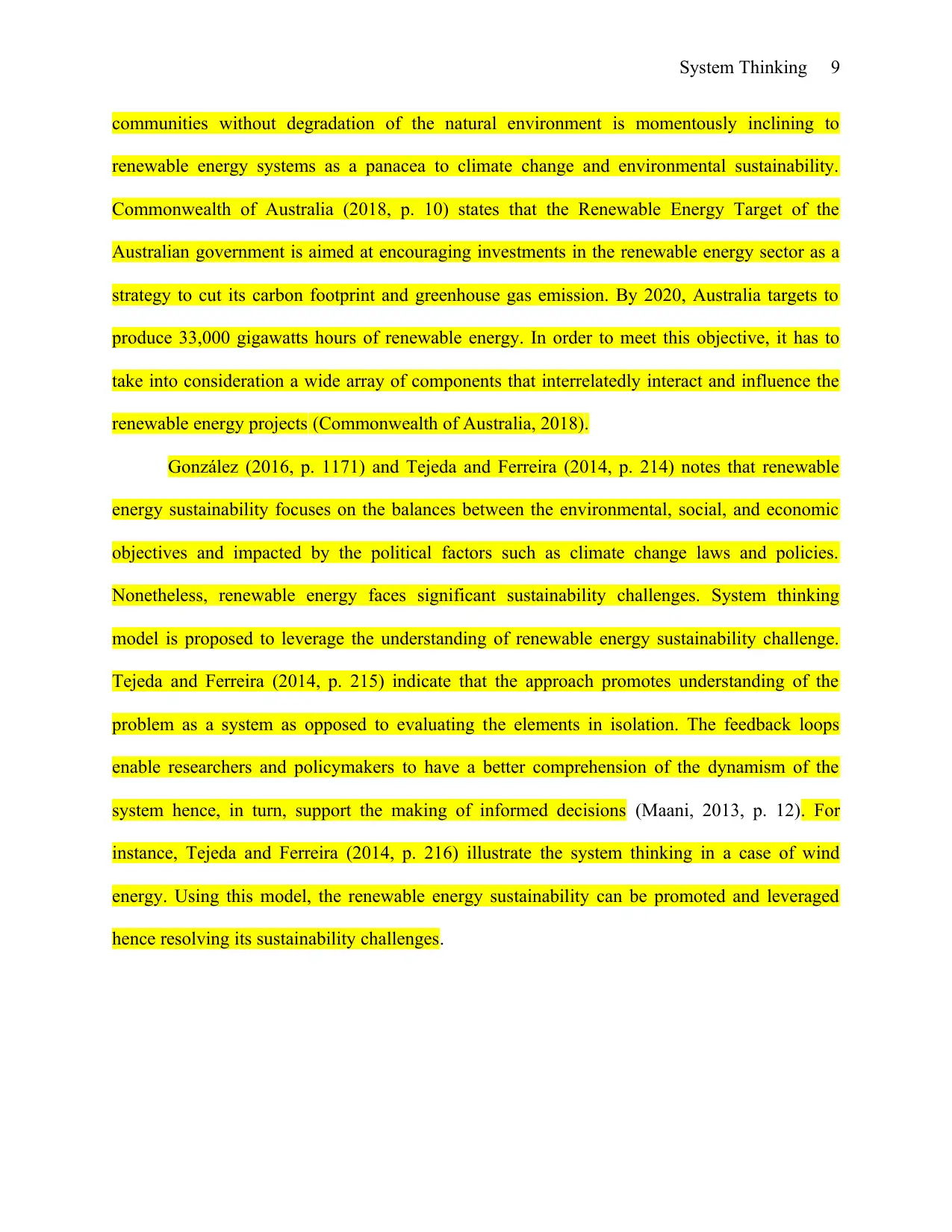
System Thinking 9
communities without degradation of the natural environment is momentously inclining to
renewable energy systems as a panacea to climate change and environmental sustainability.
Commonwealth of Australia (2018, p. 10) states that the Renewable Energy Target of the
Australian government is aimed at encouraging investments in the renewable energy sector as a
strategy to cut its carbon footprint and greenhouse gas emission. By 2020, Australia targets to
produce 33,000 gigawatts hours of renewable energy. In order to meet this objective, it has to
take into consideration a wide array of components that interrelatedly interact and influence the
renewable energy projects (Commonwealth of Australia, 2018).
González (2016, p. 1171) and Tejeda and Ferreira (2014, p. 214) notes that renewable
energy sustainability focuses on the balances between the environmental, social, and economic
objectives and impacted by the political factors such as climate change laws and policies.
Nonetheless, renewable energy faces significant sustainability challenges. System thinking
model is proposed to leverage the understanding of renewable energy sustainability challenge.
Tejeda and Ferreira (2014, p. 215) indicate that the approach promotes understanding of the
problem as a system as opposed to evaluating the elements in isolation. The feedback loops
enable researchers and policymakers to have a better comprehension of the dynamism of the
system hence, in turn, support the making of informed decisions (Maani, 2013, p. 12). For
instance, Tejeda and Ferreira (2014, p. 216) illustrate the system thinking in a case of wind
energy. Using this model, the renewable energy sustainability can be promoted and leveraged
hence resolving its sustainability challenges.
communities without degradation of the natural environment is momentously inclining to
renewable energy systems as a panacea to climate change and environmental sustainability.
Commonwealth of Australia (2018, p. 10) states that the Renewable Energy Target of the
Australian government is aimed at encouraging investments in the renewable energy sector as a
strategy to cut its carbon footprint and greenhouse gas emission. By 2020, Australia targets to
produce 33,000 gigawatts hours of renewable energy. In order to meet this objective, it has to
take into consideration a wide array of components that interrelatedly interact and influence the
renewable energy projects (Commonwealth of Australia, 2018).
González (2016, p. 1171) and Tejeda and Ferreira (2014, p. 214) notes that renewable
energy sustainability focuses on the balances between the environmental, social, and economic
objectives and impacted by the political factors such as climate change laws and policies.
Nonetheless, renewable energy faces significant sustainability challenges. System thinking
model is proposed to leverage the understanding of renewable energy sustainability challenge.
Tejeda and Ferreira (2014, p. 215) indicate that the approach promotes understanding of the
problem as a system as opposed to evaluating the elements in isolation. The feedback loops
enable researchers and policymakers to have a better comprehension of the dynamism of the
system hence, in turn, support the making of informed decisions (Maani, 2013, p. 12). For
instance, Tejeda and Ferreira (2014, p. 216) illustrate the system thinking in a case of wind
energy. Using this model, the renewable energy sustainability can be promoted and leveraged
hence resolving its sustainability challenges.
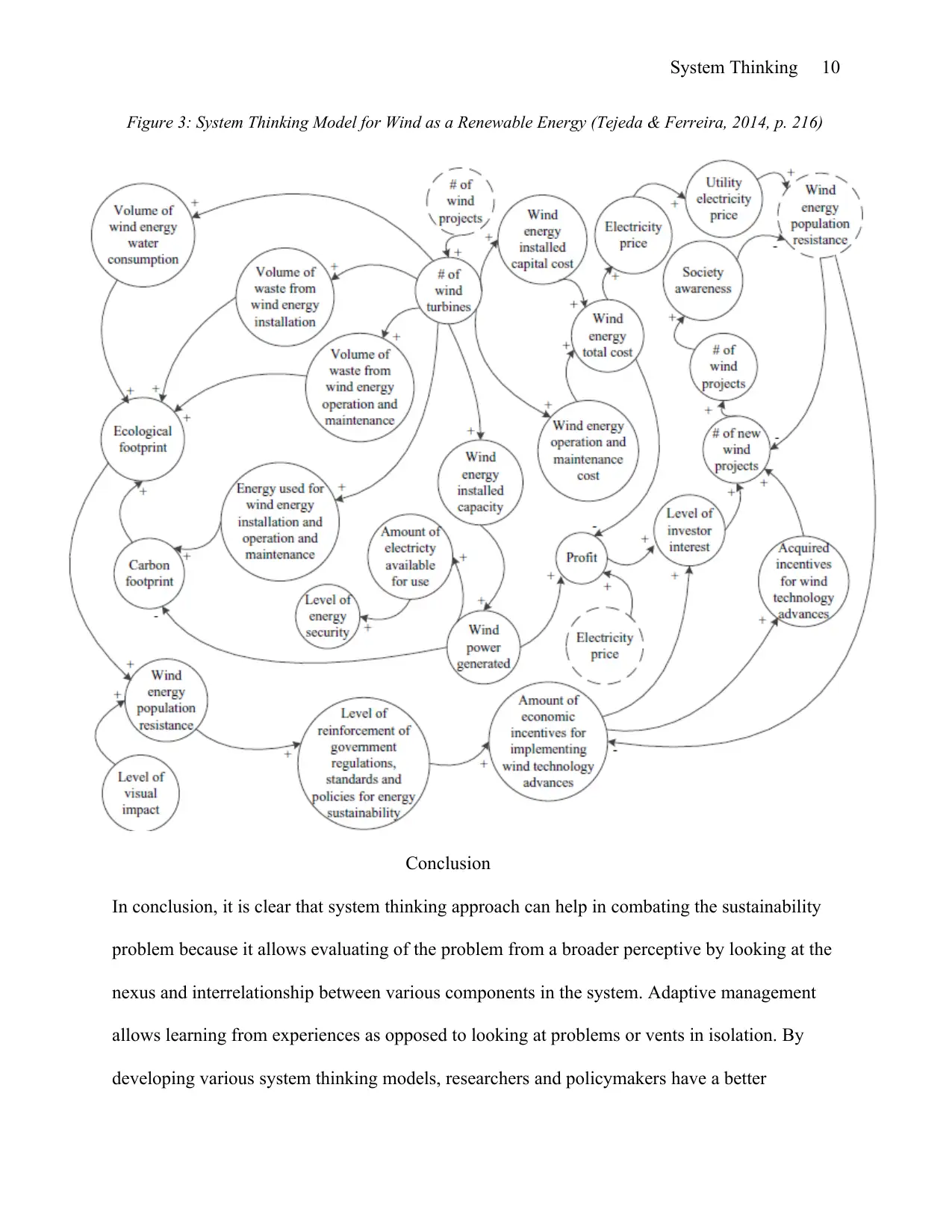
System Thinking 10
Figure 3: System Thinking Model for Wind as a Renewable Energy (Tejeda & Ferreira, 2014, p. 216)
Conclusion
In conclusion, it is clear that system thinking approach can help in combating the sustainability
problem because it allows evaluating of the problem from a broader perceptive by looking at the
nexus and interrelationship between various components in the system. Adaptive management
allows learning from experiences as opposed to looking at problems or vents in isolation. By
developing various system thinking models, researchers and policymakers have a better
Figure 3: System Thinking Model for Wind as a Renewable Energy (Tejeda & Ferreira, 2014, p. 216)
Conclusion
In conclusion, it is clear that system thinking approach can help in combating the sustainability
problem because it allows evaluating of the problem from a broader perceptive by looking at the
nexus and interrelationship between various components in the system. Adaptive management
allows learning from experiences as opposed to looking at problems or vents in isolation. By
developing various system thinking models, researchers and policymakers have a better
Secure Best Marks with AI Grader
Need help grading? Try our AI Grader for instant feedback on your assignments.
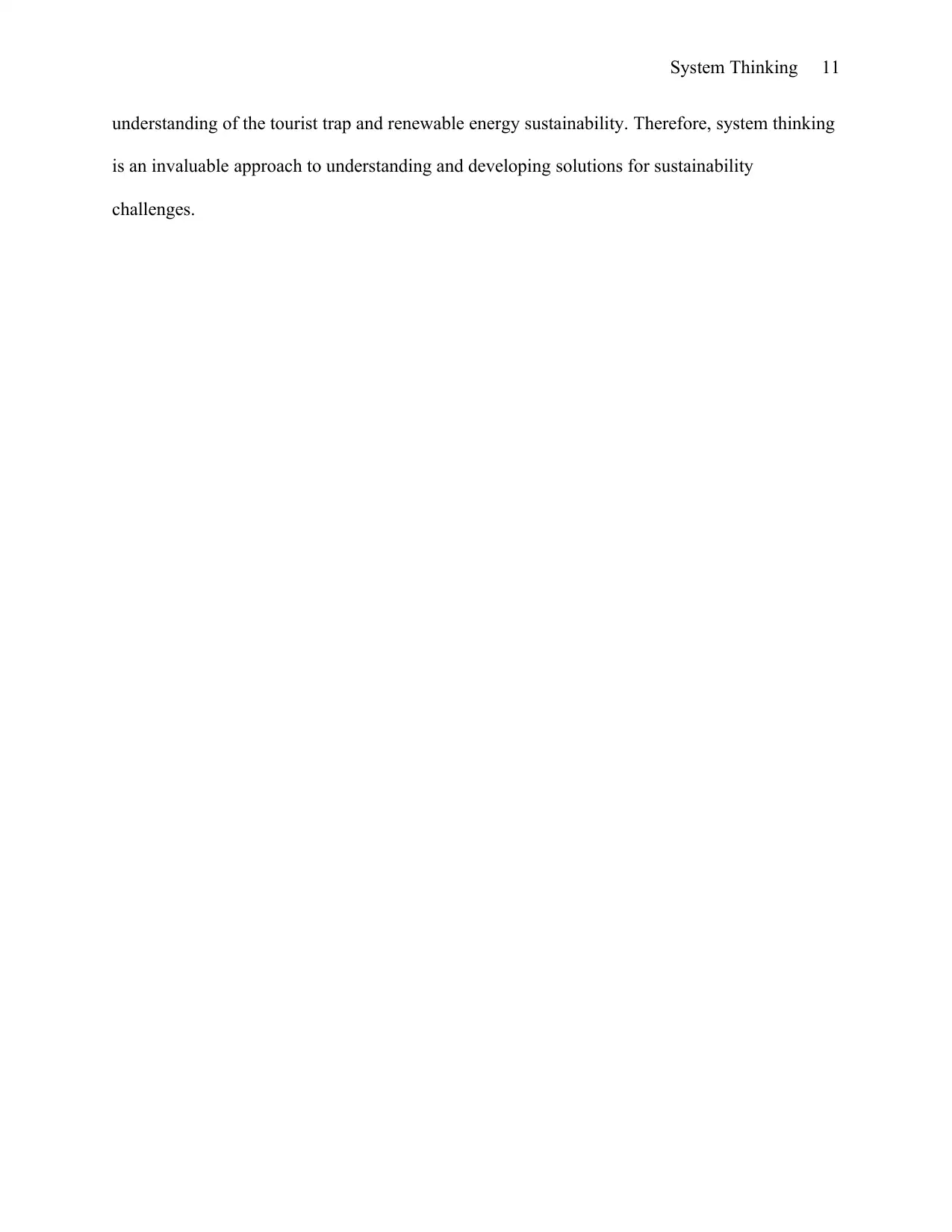
System Thinking 11
understanding of the tourist trap and renewable energy sustainability. Therefore, system thinking
is an invaluable approach to understanding and developing solutions for sustainability
challenges.
understanding of the tourist trap and renewable energy sustainability. Therefore, system thinking
is an invaluable approach to understanding and developing solutions for sustainability
challenges.
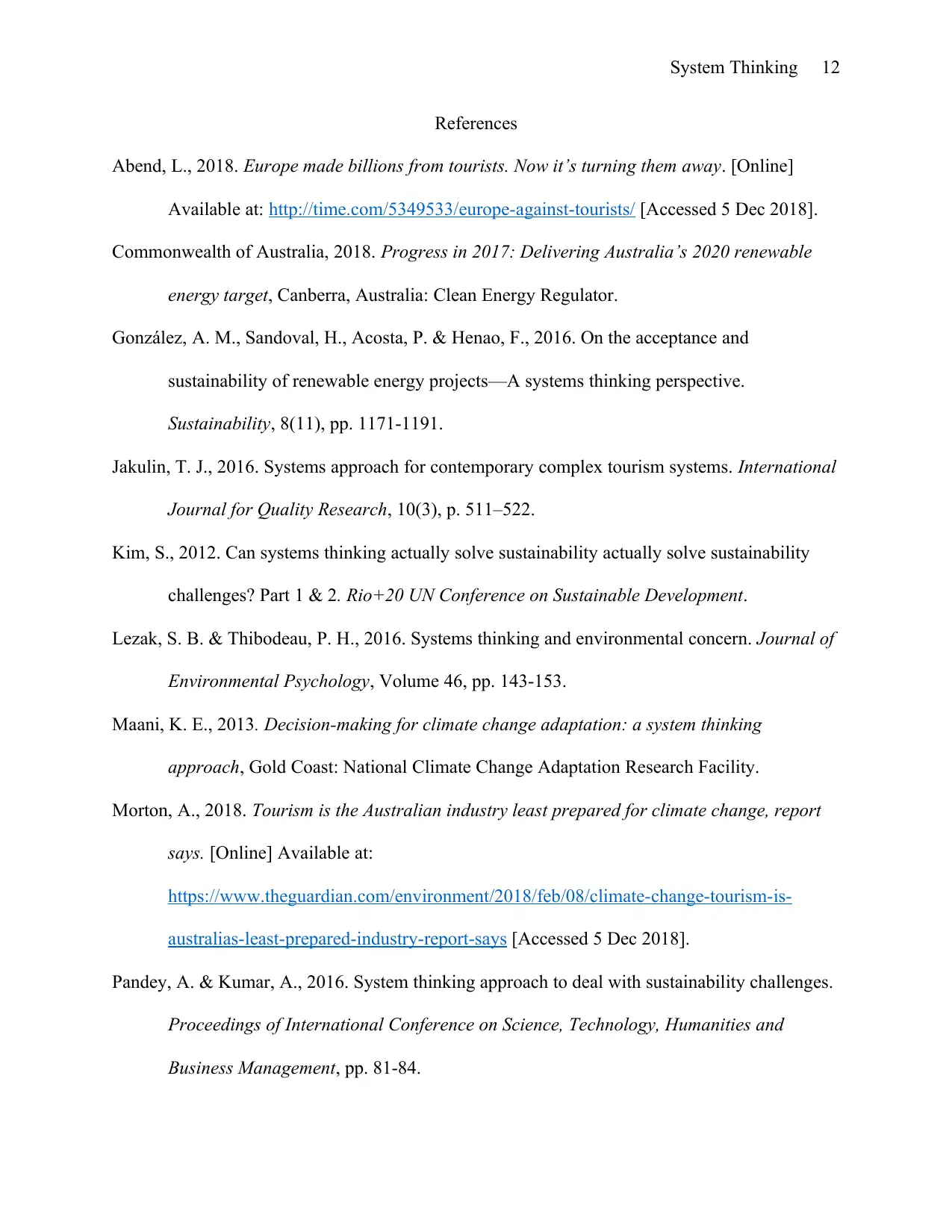
System Thinking 12
References
Abend, L., 2018. Europe made billions from tourists. Now it’s turning them away. [Online]
Available at: http://time.com/5349533/europe-against-tourists/ [Accessed 5 Dec 2018].
Commonwealth of Australia, 2018. Progress in 2017: Delivering Australia’s 2020 renewable
energy target, Canberra, Australia: Clean Energy Regulator.
González, A. M., Sandoval, H., Acosta, P. & Henao, F., 2016. On the acceptance and
sustainability of renewable energy projects—A systems thinking perspective.
Sustainability, 8(11), pp. 1171-1191.
Jakulin, T. J., 2016. Systems approach for contemporary complex tourism systems. International
Journal for Quality Research, 10(3), p. 511–522.
Kim, S., 2012. Can systems thinking actually solve sustainability actually solve sustainability
challenges? Part 1 & 2. Rio+20 UN Conference on Sustainable Development.
Lezak, S. B. & Thibodeau, P. H., 2016. Systems thinking and environmental concern. Journal of
Environmental Psychology, Volume 46, pp. 143-153.
Maani, K. E., 2013. Decision-making for climate change adaptation: a system thinking
approach, Gold Coast: National Climate Change Adaptation Research Facility.
Morton, A., 2018. Tourism is the Australian industry least prepared for climate change, report
says. [Online] Available at:
https://www.theguardian.com/environment/2018/feb/08/climate-change-tourism-is-
australias-least-prepared-industry-report-says [Accessed 5 Dec 2018].
Pandey, A. & Kumar, A., 2016. System thinking approach to deal with sustainability challenges.
Proceedings of International Conference on Science, Technology, Humanities and
Business Management, pp. 81-84.
References
Abend, L., 2018. Europe made billions from tourists. Now it’s turning them away. [Online]
Available at: http://time.com/5349533/europe-against-tourists/ [Accessed 5 Dec 2018].
Commonwealth of Australia, 2018. Progress in 2017: Delivering Australia’s 2020 renewable
energy target, Canberra, Australia: Clean Energy Regulator.
González, A. M., Sandoval, H., Acosta, P. & Henao, F., 2016. On the acceptance and
sustainability of renewable energy projects—A systems thinking perspective.
Sustainability, 8(11), pp. 1171-1191.
Jakulin, T. J., 2016. Systems approach for contemporary complex tourism systems. International
Journal for Quality Research, 10(3), p. 511–522.
Kim, S., 2012. Can systems thinking actually solve sustainability actually solve sustainability
challenges? Part 1 & 2. Rio+20 UN Conference on Sustainable Development.
Lezak, S. B. & Thibodeau, P. H., 2016. Systems thinking and environmental concern. Journal of
Environmental Psychology, Volume 46, pp. 143-153.
Maani, K. E., 2013. Decision-making for climate change adaptation: a system thinking
approach, Gold Coast: National Climate Change Adaptation Research Facility.
Morton, A., 2018. Tourism is the Australian industry least prepared for climate change, report
says. [Online] Available at:
https://www.theguardian.com/environment/2018/feb/08/climate-change-tourism-is-
australias-least-prepared-industry-report-says [Accessed 5 Dec 2018].
Pandey, A. & Kumar, A., 2016. System thinking approach to deal with sustainability challenges.
Proceedings of International Conference on Science, Technology, Humanities and
Business Management, pp. 81-84.

System Thinking 13
Pickering, C. M., Harrington, J. & Worboys, G., 2003. Environmental impacts of tourism on the
Australian Alps protected areas: Judgments of protected area managers. Mountain
Research and Development, 23(3), pp. 247-254.
Remington-Doucette, S., 2013. Chapter Two: wicked problems and their resolution from the
sustainable world: Approaches to analysing and resolving wicked problems. In: 1, ed.
Sustainable world: Approaches to analysing and resolving wicked problems. Dubuque,
Iowa: Kendall Hunt Publishing, pp. 43-80.
Scianetz, K., Kavanagh, L. & Lockington, D., 2007. The learning tourism destination: The
potential of a learning organisation approach for improving the sustainability of tourism
destinations. Tourism Management, 28(6), pp. 1485-1496.
Stoett, P., 2016. Wicked problems, dynamic solutions: the ecosystem approach and systems
thinking. Montreal, CA; Nairobi, KE: Concordia University and United Nations
Environment Programme (UNEP).
Tejeda, J. & Ferreira, S., 2014. Applying systems thinking to analyse wind energy sustainability.
Procedia Computer Science, Volume 28, pp. 213-220.
Van Mai, T. & To, P. X., 2015. A systems thinking approach for achieving a better
understanding of swidden cultivation in Vietnam. Human Ecology, 43(1), pp. 169-178.
Pickering, C. M., Harrington, J. & Worboys, G., 2003. Environmental impacts of tourism on the
Australian Alps protected areas: Judgments of protected area managers. Mountain
Research and Development, 23(3), pp. 247-254.
Remington-Doucette, S., 2013. Chapter Two: wicked problems and their resolution from the
sustainable world: Approaches to analysing and resolving wicked problems. In: 1, ed.
Sustainable world: Approaches to analysing and resolving wicked problems. Dubuque,
Iowa: Kendall Hunt Publishing, pp. 43-80.
Scianetz, K., Kavanagh, L. & Lockington, D., 2007. The learning tourism destination: The
potential of a learning organisation approach for improving the sustainability of tourism
destinations. Tourism Management, 28(6), pp. 1485-1496.
Stoett, P., 2016. Wicked problems, dynamic solutions: the ecosystem approach and systems
thinking. Montreal, CA; Nairobi, KE: Concordia University and United Nations
Environment Programme (UNEP).
Tejeda, J. & Ferreira, S., 2014. Applying systems thinking to analyse wind energy sustainability.
Procedia Computer Science, Volume 28, pp. 213-220.
Van Mai, T. & To, P. X., 2015. A systems thinking approach for achieving a better
understanding of swidden cultivation in Vietnam. Human Ecology, 43(1), pp. 169-178.
1 out of 13
Your All-in-One AI-Powered Toolkit for Academic Success.
+13062052269
info@desklib.com
Available 24*7 on WhatsApp / Email
![[object Object]](/_next/static/media/star-bottom.7253800d.svg)
Unlock your academic potential
© 2024 | Zucol Services PVT LTD | All rights reserved.